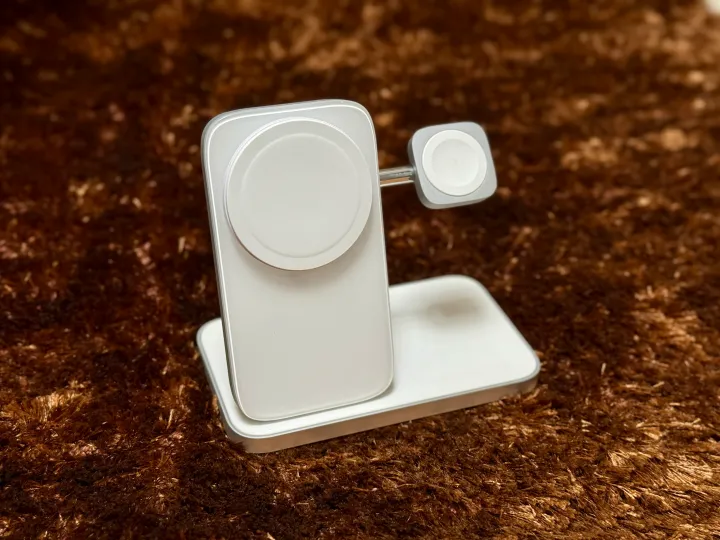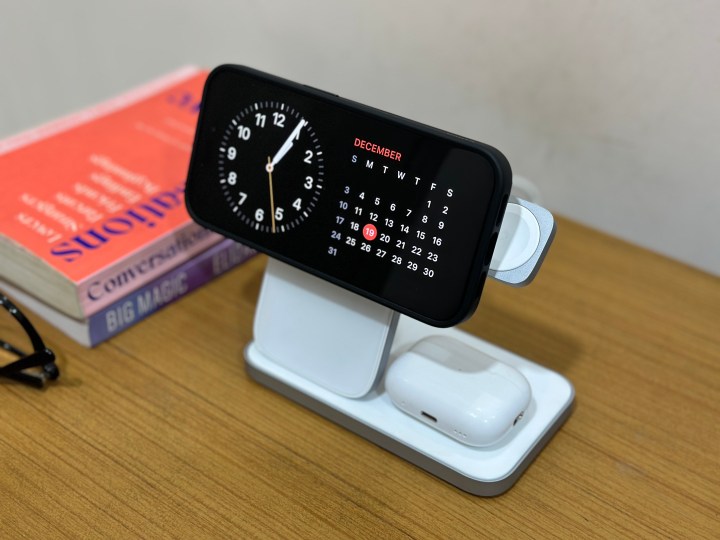
Nomad chargers have been on my table for a while now. I’ve been using the Base One Max for a few months, and while I love it, I miss the standing orientation of the Nomad Stand One — largely because it lets me skim through my iPhone notifications while I’m working on the desk without needing to pick it up.
For a long time, I’ve wished for a combination of Base One Max and Stand One, which is what the new Nomad Stand One Max is all about. And I really, really like it … for the most part.
Nomad’s build quality remains unparalleled

The Nomad Stand One Max is built out of metal and glass. It’s heavy and sits on my desk without being flimsy like some other wireless chargers. When I pick up my iPhone, it detaches without moving the charger. I have the silver variant, which comes in a two-tone finish of silver and white. It’s also available in Carbide, where you get a black-and-white color combination. It looks aesthetic and sleek on my work desk.
The Nomad Stand One Max features the official MFi MagSafe charging for the iPhone, so your phone can charge up to 15W. Being a MagSafe accessory in a standing orientation, you can’t put a non-MagSafe iPhone here, which means it’ll only charge the iPhone 12 and later.
The iPhone charging pad is accompanied by an Apple Watch fast charger, which was missing on the Base One Max. As a result, all Apple Watches from the Apple Watch Series 7 to the Apple Watch Series 9 — including the Apple Watch Ultra and Apple Watch Ultra 2 — can fast charge when placed on the Stand One Max. The third spot is a Qi charging place for AirPods, which supports other earbuds, too, like the Samsung Galaxy Buds 2 Pro.
The Nomad Stand One Max comes with a 2.0m USB-C to USB-C Nylon braided cable and needs to be connected to a minimum of 30W power adapter, which you’ll have to buy separately.
The Stand One Max has one irritating problem

The Nomad Stand One Max features great build quality and works very well for all three devices — but not every time. It can’t charge the iPhone in horizontal orientation when you’ve also placed your Apple Watch on the pad. As a result, you miss out on iOS 17’s new StandBy feature.
StandBy is meant to show you glanceable information when the iPhone is placed horizontally on a wireless charger. I charge my iPhone and Apple Watch overnight, so I’d like it to access StandBy while both my devices are charging. But the iPhone won’t attach horizontally to the Stand One Max when I’m also charging my Apple Watch.
It’s not much of an issue if you are OK with not having StandBy active on your desk or bedside or if you are charging both devices separately throughout the day. But if I have a 3-in-1 wireless charger for my Apple devices, I’d ideally like it to support all the available features.
Should you spend $180 on this iPhone charger?

The Nomad Stand One Max is priced at $180 and is available for purchase right now. Apart from the surprising incompatibility with StandBy, the Nomad Stand One Max is a solid 3-in-1 wireless charger.
It’s one of the best iPhone chargers on the market today.
I would have wholeheartedly recommended it if it supported StandBy with the Apple Watch on the pad, but because it doesn’t, that’s a limitation you’ll need to consider before throwing down your hard-earned cash. The Nomad Stand One Max is still an excellent charger, and I still recommend it despite the flaw. That’s for the sheer build quality, great looks, and the aesthetics it brings to my work desk. If the StandBy quirk doesn’t bother you, it’s one of the best iPhone chargers on the market today.
Editors' Recommendations
- This one Apple Fitness feature completely changed how I exercise
- 5 phones you should buy instead of the iPhone 15
- Why you should buy the iPhone 15 Pro instead of the iPhone 15 Pro Max
- 3 reasons why I’ll actually use Anker’s new iPhone power bank
- Here’s how Apple could change your iPhone forever




